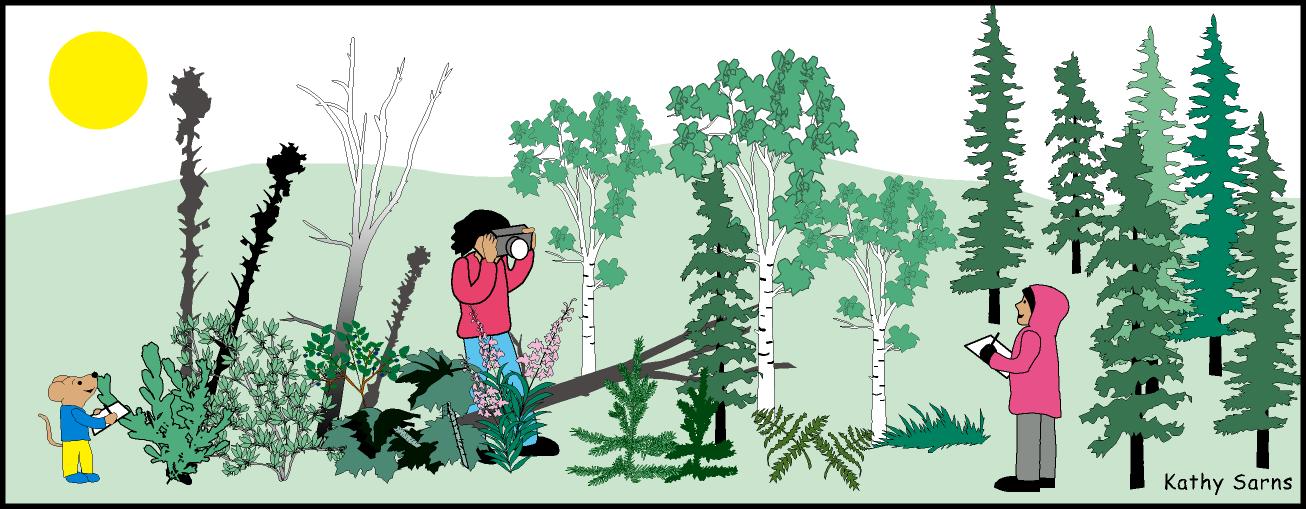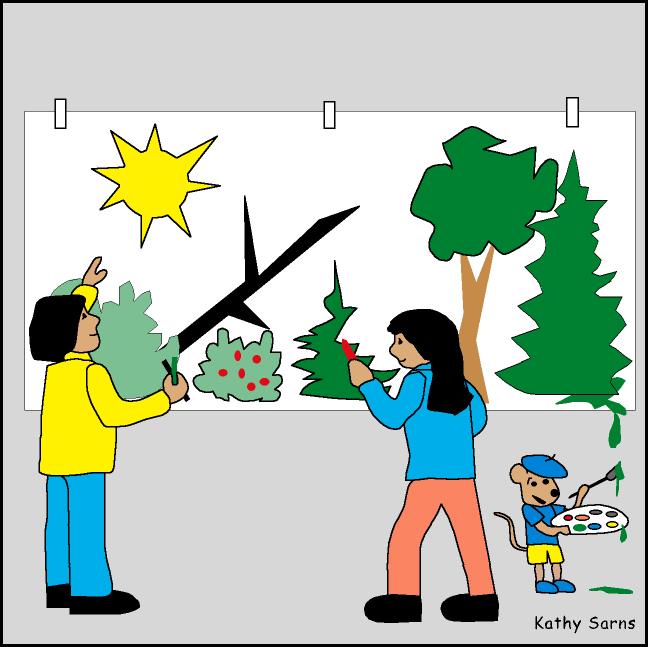
|
 |

| Grade Level: K-12 |
| Alaska State Content Standards: SA15 |
| Subject: Science |
| Skills: Observation |
| Duration: 1 class period |
| Group Size: individual |
| Setting: outdoors |
| Vocabulary: terminal bud, lateral bud deciduous trees, hedging, flagging, fungus. |
OBJECTIVE
Students describe the progressive successional stages of a boreal forest.
TEACHING STRATEGY
Students will observe and record different stages of forest succession around their school
grounds and create mural.
MATERIALS
![]() Succession of the Boreal Forest After Fire 1 per student
Succession of the Boreal Forest After Fire 1 per student
3-4 sheets of plain paper per student
pencils, crayons, markers, etc.
large sheets of white paper (for mural) for each student
colored construction paper
TEACHER BACKGROUND
The forest is always changing! Plants are growing, using the nutrients in the soil, and dying. Animals are feeding in the forest, leaving their waste, growing, and dying. Even the smallest organisms in the soil, bacteria, are very important. Bacteria break down dead organisms, putting nutrients back into the soil for plants to use.

Succession is the natural, orderly change in plant and animal communities that occurs over time. If left undisturbed, an open field may become an "aging" forest in 150-300 years. However soil conditions, climate, permafrost, topography, and natural and unnatural forces may affect the pattern of succession.
Weather, fire, flood, insects, and human activity can disrupt the forest, altering the pattern of succession. The "Succession of the Boreal Forest After Fire" handout will give you a detailed description of each stage. Although many disturbances may impact forest succession, fire is the only one that returns important nutrients to the soil.
The boreal forest provides many animals with their basic needs--food, water, shelter, and space. During the process of forest succession, an area may become more suited for some wildlife species and less suited for others.
In the "Herb Stage", (contains seed plants whose stems wither away to the ground each winter) insects and small rodents feed on the grasses, herbaceous plants, and seeds. Songbirds, such as flycatchers and warblers, feed on insects. Sparrows and grosbeaks feed on seeds, birds of prey (hawks, owls) feed on rodents (mice, voles), and game birds (ptarmigan, grouse) feed on seeds and buds. As the diversity of plants increases so does the variety of wildlife species.
Plants continue to flourish in the "Shrub Stage." Shrubs (usually low woody plants with several permanent stems instead of a single trunk,), herbs, and fallen trees provide abundant nesting cover for songbirds, rodents, game birds, and snowshoe hares. These animals attract predators such as foxes, weasels, marten, and lynx. Moose feed on shrubs and sapling trees. These animals, in turn, attract large predators like wolves.
As the forest progresses into the "Young Forest Stage," the quantity and diversity of shrubs and herbaceous plants decreases. With less variety in food available, the number of wildlife species decreases. Songbirds and birds of prey nest in the trees of a young forest. Beavers use young trees to build their lodges and feed on the tender branches.
In the "Mature Forest Stage" hardwood trees begin to die, opening the canopy for the growth of spruce. Shrubs return and make more food and cover available to songbirds, game birds, and rodents.
In the "Climax Forest Stage," dead trees called snags provide homes for woodpeckers and other cavity-nesting birds. Porcupines, squirrels, spruce grouse, and several songbird species are typical of old stands of spruce trees.
ADVANCED PREPARATION
Choose several sites on the school grounds that will illustrate forest succession.
PROCEDURE
- Have students make blank field notebooks by folding 3-4 sheets of paper in half and stapling them together.
- Prepare students for a field trip by giving them copies of the "Succession of the Boreal Forest After Fire" handout. Review on the board the stages of boreal forest succession and the major plant groups in each stage. Have them add this handout to their field notebooks.
- At each different successional site, have students determine the major plant groups. Have students list, illustrate, or take pictures of what they see for their field notebooks. Ask students to guess, based on their observations, what stage of succession they see. Remember that successional stages may not be readily apparent and that stages may blend together. You may not find all successional stages near your school.
- Back in the classroom, give the students time to review their field notebooks and add any finishing touches.
- Ask students to share their findings and their conclusions. Ask them the following questions:
- How many different successional stages did you observe? What stages where they and why do you think so?
- Was it hard to determine what stage the forest was in?
- Based on the stages seen, what do you think happened to cause the succession? What clues to you have? How could you find out if you are correct?
- What was the most interesting thing you observed?
EVALUATION
- Using the notes and observations from the field trip, have students describe the stages of succession they observed.
- Divide the class into small groups. On a large sheet of white paper have each group make a mural about local boreal forest succession using construction paper and other materials. Encourage students to be creative and suggest illustrating how fire impacts the forest and those animals living there.
- Have each group present their mural to the class explaining the types of plants and animals found in each stage of succession. Comparisons should also be made between the field experience and the mural creation.

REFERENCES
Used with permission from the “Wildfire and Wildlife” pamphlet, Alaska Department of Fish and Game, Fairbanks.
| Printable version | Add to favorites | Make Alaska FWS my homepage |
| Site designed and maintained jointly by the USFWS Alaska Region Division of Information Resource Management (IRM) and External Affairs (EA). |